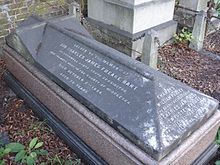- Charles James Freake
-
"Freake" redirects here. For other uses, see Freake (disambiguation).
Sir Charles James Freake, 1st Baronet (7 April 1814 – 6 October 1884) was an architect and builder, responsible for many famous 19th century facades in west London, including Eaton Square and Onslow Square. From humble beginnings and apprenticeship as a carpenter, he become a master builder, patron of the arts — especially music — and a philanthropist.
Career
Freake's father, Charles Freake, was originally a coal merchant.[citation needed] In the 1820s, he took a lease of the Royal Oak public house in Elizabeth Street, Belgravia, on the Grosvenor Estate. It appears that being a pub landlord then became his main business, but he also speculated in building locally in a small way. In 1837, he granted his son (who was described as a carpenter) a sub-lease of a small mews house in Royal Oak. In 1838, Charles James Freake (now described as a builder) acquired some house plots in Elizabeth Street. Over a five year period he built forty houses in South Eaton Place and Chester Row, and on the south side of Eaton Square.
The Grosvenor Estate's London surveyor from 1828 to 1845 was George Basevi. In 1843, Basevi and Freake were involved in a joint project in Chelsea. Basevi had designed St. Jude’s Church and Freake had been appointed to build it. So, when a new tract of land became available for development in 1843 when the lease of Thomas Gibbs’ nursery expired, Basevi used his influence to obtain the contract for Freake. The trustees signed a building agreement with Freake in April 1844.
Over the next decades, the trustees entered into new building agreements with Freake in 1849, 1850, 1855, 1861, 1862 and 1883. The land he took on included nearly all the Estate west of Pelham Crescent, amounting to 40 acres (160,000 m2). All the leases of houses were granted direct to Freake, rather than to backers or speculators.
Freake lived on the Estate for most of the years during which the development was proceeding. In 1860, he moved to Cromwell House, 21 Cromwell Road[1], which continued to be his London home for the rest of his life. The Prince of Wales and the Duke of Edinburgh were guests at 21 Cromwell Road, where he put on lavish musical and theatrical events.[citation needed] Freake built the National Training School for Music at his own expense in 1874–5, which is now the Royal College of Organists.
This particular piece of public charity earned him a baronetcy in 1882, Baronet Freake of Cromwell House. The baronetcy became extinct in 1951.
He famously only allowed straight chimneys in his buildings after his solicitor William Pulteney Scott [2] told him about soot wart — a form of cancer of the scrotum prevalent in child sweeps.[3] Straight chimneys allowed brushes to be used for the entire chimney length and would have saved many Victorian working class children from a painful and premature death.
He died in 1884 and is buried in Brompton Cemetery, London. In spite of his generosity and philanthropy he was a shrewd businessman who left approximately ₤750,000 at his death - a large fortune at the time.
Personal life
He married twice; his first wife died in childbirth, and had three daughters by his second wife. His second wife, Eliza Pudesy, died in 1900.
References
Categories:- 1814 births
- 1884 deaths
- Artists from London
- Carpenters
- English architects
- Baronets in the Baronetage of the United Kingdom
- Burials at Brompton Cemetery
- Blue plaques
- 19th-century British people
Wikimedia Foundation. 2010.


